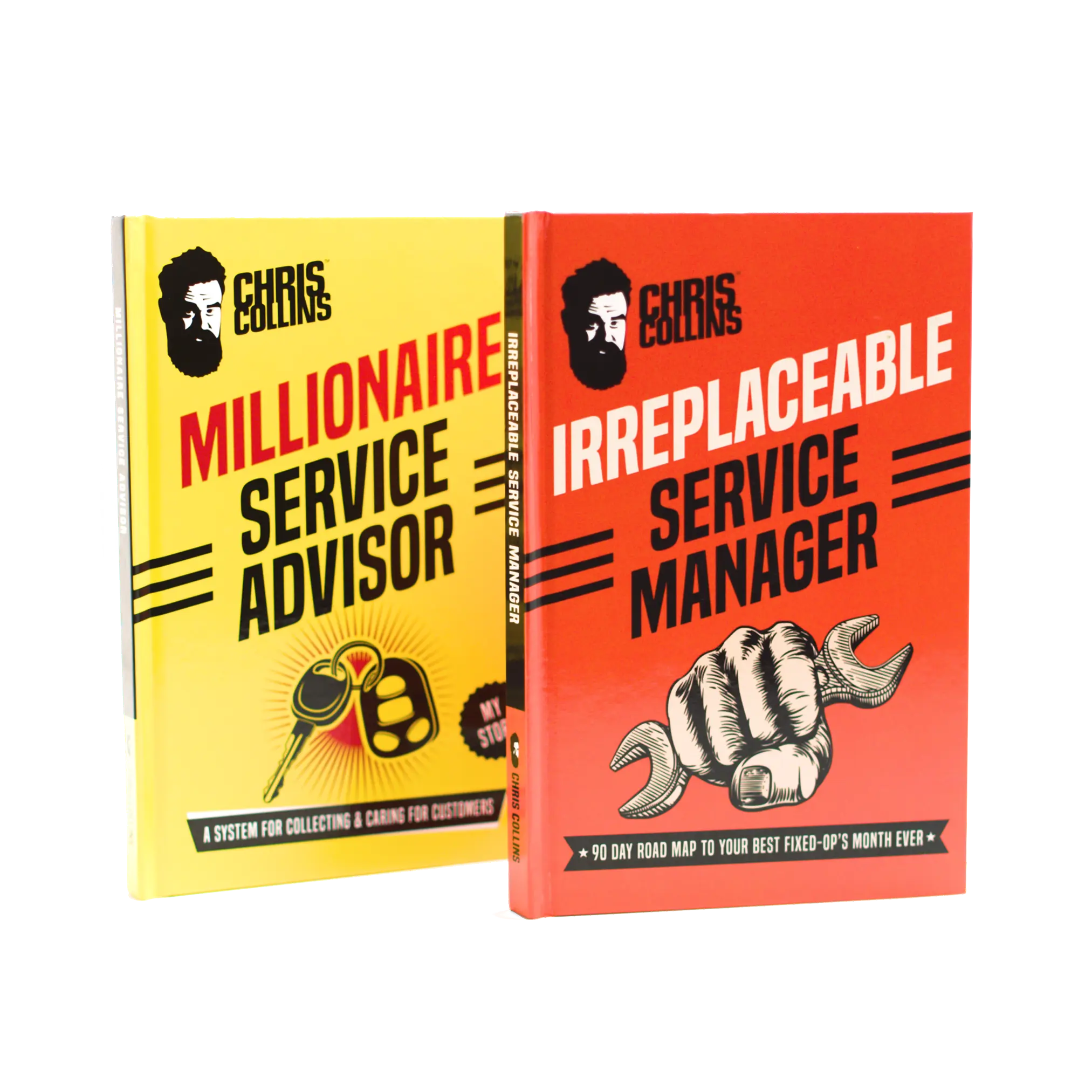There’s plenty of training for fixed ops available, but rarely do you ever encounter parts manager training specifically geared towards people in parts. This department opens up so many avenues for external and internal business. So it’s important to consider parts manager training.
And it’s really difficult to be a Parts Manager in some ways that I don’t think a service guy can appreciate. Parts manager training is essential to being successful in this role.
There are a lot of Parts Managers that are super talented, good people. But they feel alone. And with the recent parts shortages affecting our industry, they feel overwhelmed on how they should communicate these issues to their customers. While service is often just an afterthought from all the attention on sales, parts represents the unconscious.
So what do we want to do about this? PARTS HOLD!
This is the official announcement to introduce our new upcoming podcast, Parts Hold! I know a lot of our audience works in service, but this is exactly why we felt the need to branch out into parts. If people in service realize that there’s more depth to parts than just an oil filter, they’ll understand the parts side better and can work cohesively as an efficient, productive fixed ops department altogether.
It’d be really good for Service Managers and Service Directors to get another perspective of parts. And maybe there’s something that we’re missing from the service aspect that we can connect to those missing pieces. It’s almost as if we have a puzzle and we’re missing the last couple of pieces preventing us from seeing the full picture.
It’d be even better to connect the owner or the GM to the parks department, because most of the time, the owners don’t go back there. They don’t want to be involved. They typically see it as unnecessary evil for the dealership. But there’s value in them finding out that there’s actually a business that you can run out of the parts department.
The reason that General Managers and owners don’t go back to the parts departments is because they don’t understand it completely. But with Parts Hold, we’re trying to help them see this connection by putting it into conversation and kind of explaining how the parts department works in a way that everybody can understand it.

What’s Parts Hold Going to Look Like?
Coach Christian and Coach Cliff will be hosting new episodes of Parts Hold every Wednesday starting September 28th. It’s our way of giving free parts manager training to the community. Coach Cliff, from our coaching program, started off as a Parts Manager himself before branching out into service. So he understands where both service and parts come from and wants to bridge the gaps between their perspectives and understandings of each other.
Revealing Our Parts Department’s Secret Weapon…Coach Cliff!
I had Coach Cliff explain more about his past experiences and how he got to where he is today since he’s co-hosting the new show. As the parts department’s secret weapon, his experience offers great value to our audience.
So you went from parts to service…explain that.
“So I started out on the parts side. At 22, I was a Parts Manager, and I wanted to grow a business and find my own identity. So wholesale was that avenue for me early on. But as a Parts Manager, I wanted to figure out how to make more money for myself individually and for my department, and for the store. And so I figured out there was an avenue with service as well. And so I kind of focused on both avenues. Ultimately I just wanted to grow more. So that’s what opened up the door to service.”
You wanted to make more money in parts. And so how did you do that?
“Well, I figured if I spent more time in service, hanging out with the technicians, then they would buy into me. And if they believed in me, I would turn more money, because I was paid off the hours at the time. So I was paid off the hours that they produce, plus I was paid off a gross profit.”
Parts Manager Training: 7 Tips On How To Be A Good Parts Manager
With Coach Cliff’s success in both parts and service, we discussed how these two are intertwined and what strategies Parts Managers can implement to maximize their profitability.
So, for all the Parts Managers reading this, here are seven tips to keep in mind when thinking of how to take your department to the next level.
Parts Manager Training Tip 1: Maximize all potential streams of revenue
If servicing customers typically require a part, then how would techs and advisors get their jobs done and return the cars to the customers? Even simple jobs, like oil changes, need a part. Especially with the parts shortage, this is what we’re currently seeing happen in the industry. RO’s then pile up because it wasn’t effectively communicated to the advisors on which specific parts aren’t available. Techs can’t even flag their hours worked without the part they need to actually work on the car.
The parts department has multiple streams of income readily available for them to tap into– trade school, auto repair shops, fleet centers, and more. The Parts Manager has so many options to explore for supplemental income. So as a parts manager, Cliff ran his business as multiple businesses. He had an internal business, a shop business, and a wholesale business. And each one was managed differently. And each one was run differently. They were independent of each other. But if the service department closed down, he still had it.
Parts contain several businesses within a business.
Parts are not limited to service when looking for potential streams of income. They still have two other avenues. And now, there’s probably way more. Because looking back, eBay was just becoming a thing. When I was becoming the manager, we tried and did some stuff off that. But even looking at it now, online, it’d be another avenue. So I can have online internal wholesale service, and I can have it across the board. And if one fell off, I’ve got the other to fall back on.
Another strategy would be to invest in parts that turn. Define your fast-moving parts, and utilize every option you can to make sure those are the parts that are on your shelves. Most of the time, this will require an investment into a tool. Or it requires you to understand a part’s life cycle and have awareness that there will come a time that you may have to take a loss in order to open up options for a future win.
It’s also always surprising to me how many Parts Managers don’t go to SEMA. They don’t get in on vinyl wraps and things like that. Because you know, just where we are here. There are probably 20 very successful companies that are doing just vinyl wraps. Those parts managers are letting you have the first up when we sell the vehicle, and we’re letting that profit go somewhere else.
Parts Manager Training Tip 2: Parts availability directly affects the service experience
Obviously, with the parts shortage that has been impacting the auto industry, service has been suffering. This goes for a few reasons…
1) Most RO’s don’t go out without a part.
As mentioned earlier, almost all repairs require a specific part for the car to be fixed. So we need parts to do simple maintenance jobs like an oil change, with the exception of an alignment or some sort of wiring repair program installed. I would say 95% of the time or more, a part will be required to complete the job.
2) Availability of the parts depends on the Parts Manager being good at their job.
A good Parts Manager can be identified by having a high fill rate, the availability has a tremendous effect on the production or the productivity in the shop. So the technician’s efficiency, that then leads to the customer’s satisfaction in the sense that we can turn it around and the customer has their vehicle back. Also, if you don’t have the part that maybe a customer is in a rental car for a long time.
3) Good Parts Managers Will Boost CSI Score
But if a Parts Manager is really good, and we have the part in stock, we can get the part the same day, the perception of the cars the customer has, this was easy. And the technicians are going to be more efficient, because we’re not pulling them in and out.
So as a Parts Manager, the best thing I could hear at the back counter is wow, I didn’t think you’d have that. Oh, yeah, that’s, that’s a great thing. But think about it from a sense of a Parts Manager not paying attention to his oil, and they run out of oil. And then service drains the oil. And now I’ve got to figure out how to tell the customer that you’re going to have to wait for an extended period of time because I have to get all from a local place because we ran out of old.
Parts Manager Training Tip 3: The Parts Department profitability is a huge part of fixed absorption
The next one is the parts department’s profitability is a huge part of fixed absorption. The fixed absorption rate is something your dealership never wants to fall short on. For service, the gross profit comes from parts and labor sold combined. But, if you don’t have parts in stock, there’s no way to charge for labor.

Parts Manager Training Tip 4: The Relationship with Manufacturers Runs through Parts
But the manufacturer only cares about service because they’re putting a part on. They are in the business of selling parts. If you think about any vehicle that sold it is just a part. And then they want to make more money selling the parts individually than they do having it assembled as a car or a truck.
There’s an old Henry Ford poster where it was the Model A. You could buy it for $350, but to build it in the service department was like $7,500, which is 20 times more than the OEM price. And so they would rather sell a part than anything else, so the Parts Manager affects the relationship with the factory more than anything else.
If I was a GM or an owner, I would look at that, in the sense that we already talked about going directly to the main customer from the manufacturer, but they’re still gonna want to sell the parts, because they’re not gonna operate service centers.
Parts Manager Training Tip 5: The Best Parts Managers Are On Every Program For The Factory.
The best parts managers take the factory guy to lunch. They’re engaged. The worst relationship with the factory usually is a dealer that doesn’t understand parts and has a lot of turnover at the parts position. And it’s really hard for the factory to have anything predictable or set in stone.
When I was running a store, I owned the store. If the factory person came, we were washing and vacuuming their car detailing. And basically, we were taking them to lunch wherever they wanted, like, we wanted them to feel like we were in every program. We were ambassadors for the brand. It’s too important, if not the most important relationship.
And being in as many stores as we’re in over the years, the dealers that would fight the manufacturers, were always way less profitable than the ones that didn’t. There’ve been a couple times where I’ve had clients that stood up to manufacturers when things weren’t right, but I wouldn’t include them in that. It’s more for those who mismanage the relationship. You must establish boundaries. And sometimes the manufacturer oversteps in a warranty audit or whatever, you know, with the way they’re doing things, because there are bad people at manufacturers. But just their general approach involves deals on a pipeline, for sure. They are on up there, and they figured it out. They started that with CSI.
Parts Manager Training Tip 6: Good Parts Managers Help Customers Attach Their Identity to the Cars
A good Parts Manager will create a scenario where customers attach their identity to the cars. This identity is in the sense that they’re going to have a way for the customers to personalize. For example, you have a Jeep dealership, where the Parts Manager has the ability to create an environment where a Jeep customer can individualize that with a lift kit with a rap, you know, whatever it is, but that doesn’t stop with Jeep. That’s true across the board.
One thing that’s fun is to stand in a service drive and count how many aftermarket wheels or how many vehicles have some sort of individualization. And it’s always very high. So a good Parts Manager creates a scenario where we’re selling BMW luggage. Or we’re selling Porsche driving shoes, lift kids, and more.
I even think with the lift kits, that’s a huge thing in several different markets that I’ve been around. Like those guys that have that stuff and have the cars displayed. These are the pocket possibilities. Have a portfolio laid out with pictures of stuff you’ve done. Have the customer take pictures of them out camping with their overland tent and grill and coolers and all that. And have all that stuff available that they can see in touch.
Try Out This Strategy– Personalization!
I learned this when I worked as a Service Advisor at a Cadillac dealership. So they had a company that was called Prestige Products. I don’t know what their deal was because I was an advisor, but it still made an impression on me.
So what Prestige Products did is they had a deal where they had a stall with their own technician. And then they had a salesperson and that salesperson got in with every customer going into f&i. They had this red carpet area that the car would get pulled into. And they were like in a lab coat and then they had all these wheels. For Cadillac back then (not as much now), the trend was the Vogue tires. So they would always have Vogue tires. I mean, they had stuff that was garbage like where you could do wood paneling on your dash. There was a sticker. It was total garbage but people still bought it. You could gold plate just about anything.
We had a guy that gold plated the metal, like a crashed bumper on the front that you’d put a winch on and it was gold plated. It was terrible. But that machine, the gold plate, they had DVD players for the headrest, they had all this stuff. But they would meet the customer before they went into f&i and then say, “Hey, I’m here to help you personalize.” They’d ask questions like, “Do you have kids?” They would do a needs analysis.
Then they would roll wheels up next to the car and showcase more parts they could sell. Their closing ratio was extremely high. They did big numbers. But from the service drive, we got 10% of whatever was sold. So if somebody came in and their Vogue tires were worn down, or they didn’t have Vogue tires, then we could pull a car over there and put stuff next to it. And I always thought, “Wow, that this is a very unique thing that creates a ton of revenue.”
How does this game play actually look in action?
So when I was running a BMW store as General Manager, I had two advisors helping me execute this strategy. I had an advisor that was meeting people before they went to f&i, and if it was for personalization, then they would send an email. And we were giving them like 15% off for 30 days. So there was urgency.
And we were doing $200,000 a month in parts and labor with dedicated techs and two advisors. Because you couldn’t cover the time with the number of vehicles that were selling. And it worked.
The only downside to it was a lot of times customers would fall in love with $10,000 worth of stuff. It sort of unwinds a deal and somebody’s got edgy credit. And we can’t get more. So, what we would try to do in that situation is the manager would be like, “You’re only selling them something if they got the cash.” And trust me they borrowed the money from mom. So they don’t want to have any more money. But that was the only thing. You know, sometimes it creates an issue for the desk, or for f&i. But, don’t throw the baby out with the bathwater, for the most part this can be fixed through simply communicating.

Parts Manager Training Tip 7: Good Parts Managers Have Huge Effects on Customer Satisfaction (CSI Score)
So tagging off of personalization, parts managers can have a huge effect on how the customer feels. Because if a customer personalizes their vehicle, they’re going to feel like the car is a part of them.
So just take for example my Range Rover that I got wrapped up. The wheels are powder coated and the car is wrapped. And it’s a wrap that when I go places, and I come out of the store, people are videotaping it. I’m driving on the freeway, and people are trying to pull up to take pictures of it. It’s funny, oftentimes, like I have to excuse myself to get in for people to get away from it. I don’t even exist in that sense.
But, everywhere I go, people are acknowledging it. It’s making them smile. They’re giving me a thumbs up. What does that do to me as a consumer, when my vehicle that I’ve designed and I’ve personalized, has a reaction everywhere I go? I’m getting positive feedback, especially in a world where you want likes. And all that is the best outcome, and so parts affect that.
An Ending Note
I don’t understand why most parts managers just don’t even think this way. Because this is the best way to affect how people feel, and their enthusiasm for the brand or for their vehicle. It transcends if we can do something to the vehicle, and you put a lift kit on a truck and some wheels. And then they go to work and people are like, “Holy cow, I love your truck” and come over there. You think about what people would do for stupid likes. Like, now you’re talking about real actual human connection?










